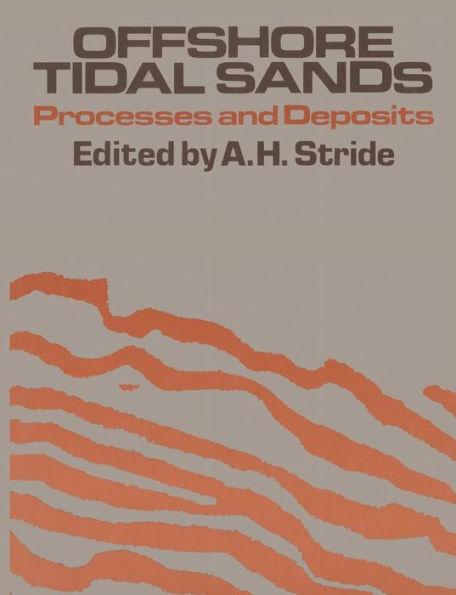5
1


Paperback(Softcover reprint of the original 1st ed. 1982)
$54.99
-
PICK UP IN STORECheck Availability at Nearby Stores
Available within 2 business hours
Related collections and offers
54.99
In Stock
Overview
In the early 1970s a start was made on a broad review of what was known or could be surmised about sedimentation by strong tidal currents on modern continental shelves. This task was initiated because of the need to define the next phase of research in this field by the Marine Geology Group of the Institute of Oceano graphic Sciences. Related indications of the longer term evolution of the deposits were sought by close reference to the nature of modern tidal currents and the supposedly offshore tidal deposits of ancient seas. As the review grew in completeness it became of increasing relevance to a wider audience so it was amalgamated with the new results and shaped as a book. The fruits of the long-continued discussions within and outside the Geology Group have served to improve understanding of the processes and products of offshore tidal current sedimentation. On the other hand, the discussions have blurred the parts played by the people concerned. This applies to all chapters in varying degrees, but is especially true for Chapters 3, 4 and 5. The authorship attributed to each chapter therefore seeks to reflect those who were most concerned with it.

Product Details
| ISBN-13: | 9789400957282 |
|---|---|
| Publisher: | Springer Netherlands |
| Publication date: | 10/15/2011 |
| Edition description: | Softcover reprint of the original 1st ed. 1982 |
| Pages: | 222 |
| Product dimensions: | 7.44(w) x 9.69(h) x 0.02(d) |
Table of Contents
1. Background and outline.- 1.1 Introduction.- 1.2 History of research on modern offshore tidal current sedimentation.- 1.3 A depositional surface for late Holocene deposits.- 1.4 Limits and outline of the book.- 2. Tidal currents of the continental shelf.- 2.1 Introduction.- 2.2 Tide generating forces and the ocean’s response.- 2.3 Tidal currents in shelf seas.- 2.4 Net sand transport caused by tidal current asymmetries.- 2.5 Flow near the sea floor.- 2.6 Internal tides.- 2.7 Tides past.- 2.8 Main conclusions.- 3. Bedforms.- 3.1 Introduction.- 3.2 Relevant flume bedforms.- 3.3 Transverse bedforms of the continental shelf 34.- 3.4 Longitudinal bedforms of the continental shelf.- 3.5 Relationship between bedforms.- 3.6 Aeolian equivalents.- 3.7 Main conclusions.- 4. Sand transport.- 4.1 Introduction.- 4.2 Relation of sand transport rate to tidal current speed.- 4.3 Geographical variation in sand transport rate.- 4.4 Net sand transport by tidal currents.- 4.5 Temporal variations of sand transport rate and direction in a tidal sea.- 4.6 Growth, migration and decay of sand waves in the Southern Bight of the North Sea by total water movements.- 4.7 Local sand transport on modern sand banks.- 4.8 Main conclusions.- 5. Offshore tidal deposits: sand sheet and sand bank facies.- 5.1 Introduction.- 5.2 Late Holocene sand and gravel sheet facies.- 5.3 Sand bank facies.- 5.4 Sediment and faunal indicators of shape, depth and exposure of continental shelves.- 5.5 Longer term evolution of the deposits.- 5.6 Sand and gravel deposits of non-tidal marine currents.- 5.7 Main conclusions.- 6. Shelly faunas associated with temperate offshore tidal deposits.- 6.1 Introduction.- 6.2 Faunal associations.- 6.3 Bioturbation.- 6.4 Topics and areas excluded.- 6.5 Temperate water regions studiedand their geological importance.- 6.6 Faunas in shallow nearshore waters.- 6.7 Faunas of the middle and outer continental shelf.- 6.8 Faunas of a bed-load parting.- 6.9 Faunas associated with bedform zones in the Western English Channel.- 6.10 Faunas associated with bedform zones in the Bristol Channel.- 6.11 Faunas associated with bedform zones in the Southern North Sea.- 6.12 Faunas associated with bedform zones on the Atlantic continental shelf between Brittany and Scotland.- 6.13 Faunas of active sand banks.- 6.14 Faunal evidence for stability of sand waves.- 6.15 Faunas as environmental indicators.- 6.16 Factors determining the faunal composition of death assemblages in shell gravels.- 6.17 Age of temperate water carbonates.- 6.18 Relative proportions of the major carbonate producers in death assemblages of continental shelf carbonates.- 6.18.1 Faunal composition of death assemblages in shell gravels in the strong current areas, Western English Channel and Celtic Sea.- 6.18.2 Faunal composition of death assemblages in shell gravels on the continental shelf west of Scotland.- 6.19 Temporal changes in the faunal composition of shell gravels.- 6.20 Long term evolution of temperate shelf carbonates.- 6.21 Applications to the fossil record.- 6.22 Main conclusions.- 7. Ancient offshore tidal deposits.- 7.1 Introduction.- 7.2 Recognition of ancient offshore tidal current activity.- 7.3 Structures preserved in ancient offshore tidal current deposits.- 7.4 Tidal currents aided by storm processes.- 7.5 Factors controlling the structure and composition of offshore tidal sediments through geological time.- 7.6 Some possible palaeotidal regimes.- 7.7 Sedimentology of a tidal sea: the Lower Greensand of southern England.- 7.8 Tidal currents through geological time: implicationsfor future studies.- 7.9 Main conclusions.- REFERENCES.From the B&N Reads Blog
Page 1 of
